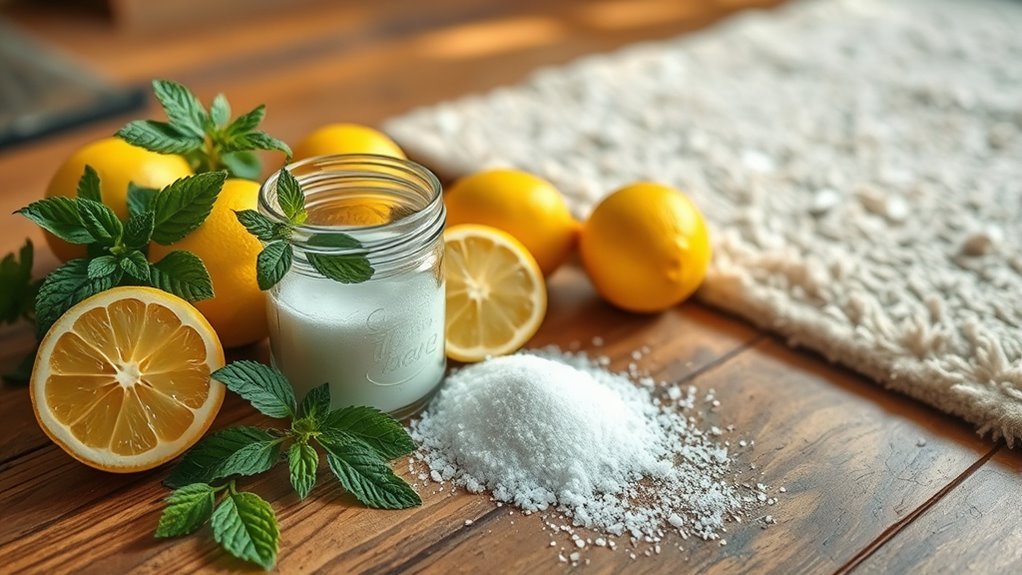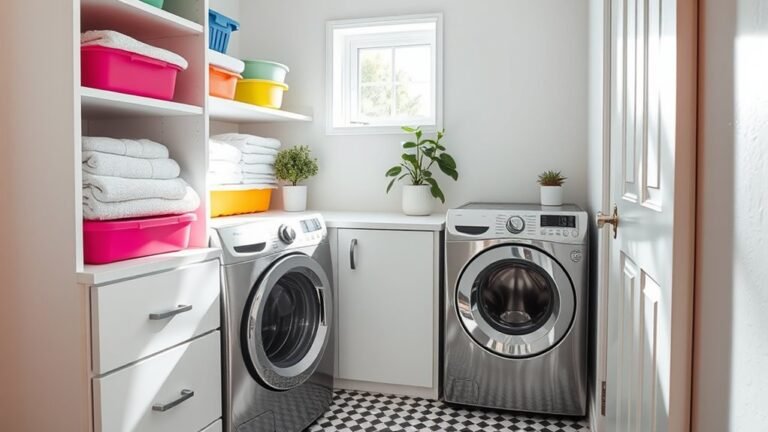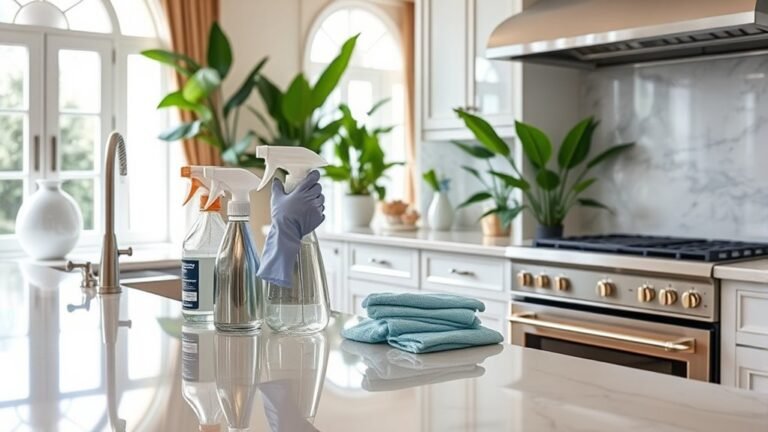DIY Cleaner for Rug
You can make a DIY rug cleaner using precise, natural ingredients for safe, effective cleaning. Mix one cup distilled white vinegar with two cups warm water and add one teaspoon mild liquid Castile soap. Test a small rug corner first for colorfastness. For odors, sprinkle baking soda, let sit, then vacuum. Use a soft brush and microfiber cloths for gentle agitation and blotting. Proper testing and maintenance guarantee rug longevity. Discover more techniques to keep your rug fresh and stain-free.
Benefits of Using Homemade Rug Cleaners

Although commercial rug cleaners offer convenience, using homemade rug cleaners gives you precise control over the ingredients and their concentrations, reducing exposure to harsh chemicals. This control minimizes the environmental impact by avoiding synthetic compounds that can pollute water systems. Additionally, by selecting and measuring each component yourself, you prevent unnecessary waste and chemical overuse, aligning with sustainable practices. From a financial standpoint, homemade solutions generate significant cost savings since you utilize common household ingredients instead of expensive commercial products. You also avoid repeated purchases driven by proprietary formulas. Methodically preparing your own cleaner empowers you to tailor the solution to your specific rug type and soil level, enhancing cleaning efficiency without compromising safety. This approach grants you autonomy, aligning with your desire for freedom in maintaining a clean, healthy home environment.
Essential Ingredients for DIY Rug Cleaning Solutions
When crafting your own rug cleaning solution, understanding the essential ingredients is crucial to achieving effective and safe results. You’ll want to focus on components that boost cleaning effectiveness while remaining eco friendly alternatives to harsh chemicals. Here’s a concise guide to key ingredients:
| Ingredient | Purpose | Notes |
|---|---|---|
| White vinegar | Disinfectant, deodorizer | Natural, non-toxic |
| Baking soda | Odor neutralizer | Enhances stain lifting |
| Liquid Castile soap | Surfactant | Biodegradable, gentle |
| Essential oils | Fragrance, antimicrobial | Optional, eco friendly |
Using these ingredients, you gain control over the cleaning process, ensuring your rug remains fresh without compromising environmental safety.
How to Remove Stains From Rugs Naturally

To remove stains from your rug naturally, you’ll need to understand common natural stain removers like vinegar, baking soda, and lemon juice. Each ingredient targets specific stain types through chemical reactions that break down residues without harsh chemicals. Next, you can prepare effective homemade cleaning solutions by combining these elements in precise ratios for ideal stain removal.
Common Natural Stain Removers
Since rugs often attract a variety of stains, knowing which natural agents effectively break down specific substances is essential. You can rely on common household products as eco friendly options to tackle stains without harsh chemicals. For protein-based stains like food or blood, cold water combined with a dab of plain white vinegar helps denature proteins, easing removal. Oil-based stains respond well to baking soda, which absorbs grease when sprinkled directly and left to sit before vacuuming. Tannin stains from coffee or wine can be lifted using diluted lemon juice, which acts as a mild natural acid, breaking down pigments. By selecting the right natural remover based on the stain type, you maintain your rug’s integrity while embracing freedom from synthetic cleaners.
Effective Homemade Cleaning Solutions
Understanding which natural agents target specific stain types sets the foundation for creating effective homemade cleaning solutions. You’ll want to match ingredients like white vinegar and baking soda for acidic stains, or hydrogen peroxide for protein-based marks. These eco friendly alternatives not only reduce chemical exposure but also offer cost effective solutions compared to commercial cleaners. For instance, a mixture of one part white vinegar to two parts water can effectively lift coffee or wine stains. Applying baking soda afterward neutralizes odors and absorbs residual moisture. Always test a small rug area first to verify colorfastness. By methodically tailoring your approach to stain composition, you maintain your rug’s integrity and cleanliness while embracing sustainable, budget-friendly practices that give you control over what touches your home environment.
Step-by-Step Guide to Making a Vinegar-Based Cleaner
Three simple ingredients are all you need to create an effective vinegar-based cleaner for your rug. Start by combining one cup of distilled white vinegar—valued for its natural acidity and antimicrobial vinegar benefits—with two cups of warm water. Add one teaspoon of mild liquid dish soap to enhance grease-cutting power without harsh chemicals. Mix these eco friendly options thoroughly in a spray bottle for easy application. Before use, test a small, inconspicuous rug section to verify colorfastness. Spray the solution evenly over the stained area and allow it to sit for five minutes. Gently blot with a clean cloth, avoiding rubbing to prevent fiber damage. This method leverages vinegar’s natural cleaning strength while maintaining a non-toxic, sustainable approach to rug care.
Using Baking Soda to Eliminate Odors From Rugs

Although many cleaning agents tackle stains effectively, baking soda excels at neutralizing odors trapped within rug fibers. To harness baking soda benefits, evenly sprinkle a generous layer over the rug surface. Allow it to sit undisturbed for at least 30 minutes to maximize odor absorption. For deeper odor issues, extend this period to several hours or overnight. Afterward, use a vacuum cleaner with strong suction to thoroughly remove the baking soda, ensuring no residue remains. This method leverages baking soda’s chemical properties to absorb and neutralize volatile odor molecules without introducing harsh chemicals. By following this precise process, you maintain your rug’s freshness and integrity while embracing an eco-friendly, effective solution that grants you freedom from commercial odor eliminators.
Safe Cleaning Methods for Delicate Rug Fibers
While baking soda effectively neutralizes odors without harming rug fibers, cleaning delicate rugs requires even more careful techniques to avoid damage. You’ll want to employ gentle methods that prioritize fiber protection. Start by vacuuming with a soft brush attachment to remove surface dirt without agitation. For spot cleaning, dilute mild, pH-neutral detergent in water, testing a small hidden area first to verify colorfastness and fiber integrity. Apply the solution sparingly using a soft cloth, gently blotting rather than scrubbing to prevent fiber distortion. Avoid excessive moisture, which can weaken delicate fibers and cause shrinkage. After cleaning, dry the rug flat in a well-ventilated area, away from direct sunlight. These precise, controlled steps give you freedom to maintain your rug’s beauty while safeguarding its delicate structure.
Tips for Spot Cleaning vs. Deep Cleaning Rugs
When dealing with rug maintenance, distinguishing between spot cleaning and deep cleaning is essential to apply the appropriate technique and avoid unnecessary wear. Spot cleaning targets specific stains or spills immediately, using minimal moisture and gentle agitation to prevent spreading or fiber damage. You should blot the area promptly with a clean cloth and apply a suitable DIY cleaner directly for effective stain removal. Deep cleaning, on the other hand, involves treating the entire rug to remove embedded dirt and allergens. This process requires thorough rinsing and drying to preserve fiber integrity and prevent mold growth. By recognizing when to employ spot cleaning versus deep cleaning, you maintain your rug’s appearance and longevity while exercising effective, freedom-supporting care methods.
How to Test DIY Cleaners on Your Rug Before Use
How do you guarantee a DIY cleaner won’t damage your rug before applying it broadly? First, identify your rug material, as natural fibers (wool, cotton) and synthetics (nylon, polyester) react differently to cleaning agents. Next, perform a colorfast test: apply a small amount of the cleaner on an inconspicuous area, like the rug’s underside or a corner. Wait 10-15 minutes, then blot with a white cloth. If no color transfers and the rug fibers remain intact, the cleaner is likely safe to use. If you notice discoloration, fiber damage, or residue, do not proceed. This methodical step preserves your rug’s integrity and guarantees your DIY cleaning supports your freedom to maintain it without costly damage. Always test before full application.
Tools and Supplies Needed for Effective Rug Cleaning
To clean your rug effectively, you’ll need specific tools like a soft-bristle brush, a spray bottle, and clean microfiber cloths. Natural ingredients such as white vinegar, baking soda, and mild liquid soap are essential for creating safe, effective DIY cleaning solutions. Having these supplies ready guarantees a thorough and controlled cleaning process.
Essential Cleaning Tools
Although effective rug cleaning depends largely on technique, having the right tools guarantees thorough and efficient results. Start with a high-quality vacuum cleaner to remove loose dirt and debris from rug fibers. Opt for adjustable suction settings to protect delicate materials while securing deep cleaning. Next, use a microfiber cloth for spot cleaning and drying. Its fine fibers trap dust and absorb moisture without damaging the rug surface. You’ll also need a soft-bristle brush to agitate stains gently, preventing fiber distortion. A spray bottle allows precise application of your cleaner, minimizing saturation and drying time. Finally, a sturdy bucket helps mix cleaning solutions evenly. Equipping yourself with these tools ensures you maintain your rug’s integrity while achieving freedom from dirt and stains.
Natural Cleaning Ingredients
Since the effectiveness of a rug cleaner depends on its composition, selecting natural ingredients with specific properties is crucial. You’ll want to focus on components that maximize cleaning efficiency without compromising the rug’s fabric. Baking soda acts as a mild abrasive and deodorizer, effectively loosening dirt particles. White vinegar provides acidic properties that break down stains and neutralize odors. Castile soap, a plant-based surfactant, efficiently removes grease and grime while being gentle on fibers. Essential oils like tea tree or lavender add antimicrobial benefits and a fresh scent. Combining these natural ingredients in precise ratios guarantees the best cleaning efficiency and fabric preservation. By choosing these tools, you maintain control over the cleaning process, avoid harsh chemicals, and empower yourself to clean your rug effectively and safely.
Maintaining Your Rug Between Cleanings
Even if you clean your rug thoroughly, maintaining it between deep cleanings is essential to preserve its appearance and longevity. Focus on consistent rug maintenance tips like regular vacuuming to remove surface dirt and prevent fiber damage. Adjust cleaning frequency based on foot traffic; high-traffic areas require more frequent attention. Rotate your rug periodically to guarantee even wear and minimize fading. Address spills immediately using blotting techniques with a clean cloth to prevent stains. Use protective pads underneath to reduce friction and prolong fiber integrity. Schedule professional deep cleanings annually or biannually, depending on usage. By implementing these precise, methodical steps, you maintain your rug’s quality, granting you the freedom to enjoy your space without concern for premature wear or costly repairs.
Frequently Asked Questions
How Often Should I Deep Clean My Rug With DIY Solutions?
Think of your rug as a living ecosystem that needs regular care to thrive. For ideal deep cleaning frequency, aim to clean it every 6 to 12 months, depending on foot traffic and exposure to dirt. Rug maintenance tips include vacuuming weekly, spot-treating stains promptly, and rotating the rug periodically. This methodical approach guarantees your rug remains fresh and durable while giving you the freedom to enjoy a clean, healthy living space.
Can DIY Cleaners Be Used on Outdoor Rugs?
You can use DIY cleaners on outdoor rugs, but you need to take into account the outdoor materials first. Some fibers like polypropylene handle water and DIY solutions well, ensuring cleaning effectiveness without damage. However, natural fibers may absorb moisture and deteriorate. Test your cleaner on a small area to avoid fading or weakening. By understanding your rug’s composition, you’ll maintain both durability and appearance while enjoying the freedom of DIY maintenance.
Are Homemade Rug Cleaners Safe for Pets and Children?
You might think every homemade rug cleaner could clear a mountain of grime without harm, but safety is key. To guarantee pet friendly ingredients and child safe methods, always opt for natural substances like vinegar, baking soda, and mild essential oils in diluted forms. Avoid harsh chemicals or undiluted substances. Test small areas first, monitor reactions, and maintain ventilation. This methodical approach lets you clean freely without risking your loved ones’ health.
How Do I Store Leftover DIY Cleaning Solutions?
You should store leftover DIY cleaning solutions in airtight containers, labeled with the date and contents to guarantee proper storage. Keep them in a cool, dark place away from direct sunlight and heat sources to maintain the solution’s effectiveness. Note the solution shelf life varies, but generally, use within one to two weeks is recommended. This method preserves the formula’s potency while giving you the freedom to reuse safely and efficiently.
Can I Use DIY Rug Cleaner on Carpeted Stairs?
Did you know that 75% of home accidents occur on staircases, often due to dirty or slippery carpets? When it comes to stair cleaning, you can use DIY rug cleaner on carpeted stairs, but apply it carefully to avoid over-wetting. Proper carpet maintenance on stairs requires precise, controlled application and quick drying to prevent mold or damage. Use a spray bottle for even coverage and blot rather than scrub to preserve carpet fibers and guarantee safety.






